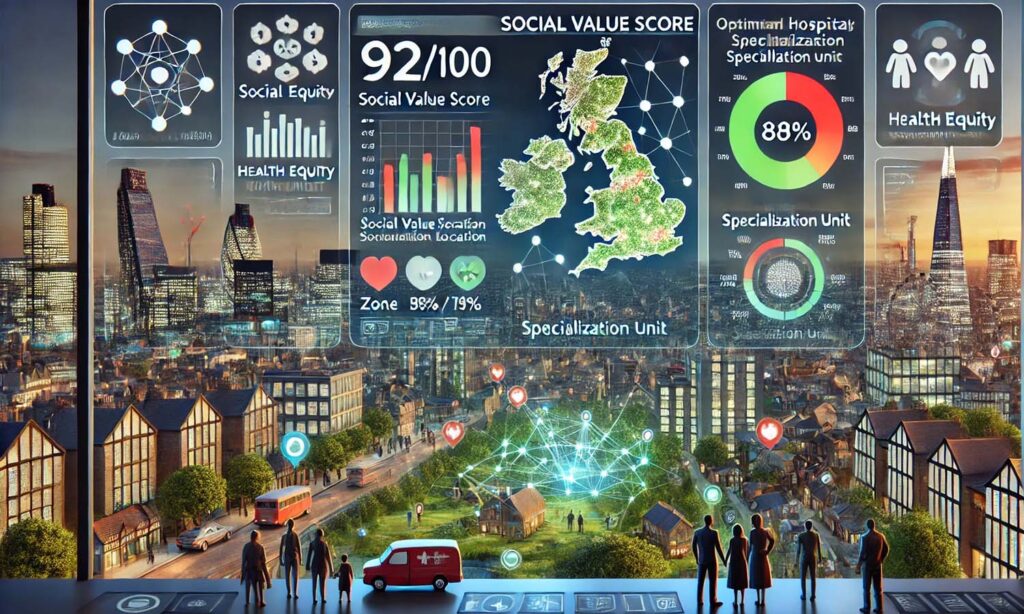In an era where infrastructure investments shape our communities for decades, the question remains: how do we ensure these projects deliver meaningful social value? Traditional approaches rely heavily on subjective assessments, making it difficult to quantify true impact across diverse stakeholder needs. Synegys aims to solve this challenge with their AI-powered Social Value Impact Dashboard (SVID), bringing objectivity and predictive insights to infrastructure planning.
The Social Value Challenge in Infrastructure
Infrastructure planning has traditionally been a balancing act between competing priorities. Policy makers must allocate limited resources across various needs. Construction companies focus on efficiency and cost management. Healthcare providers want optimal patient outcomes. The general public expects accessibility, equity, and community benefits. With these diverse stakeholders, subjective evaluations often lead to inconsistent decision-making.
“The difficulty in quantifying social value has led to infrastructure investments that sometimes miss their mark in truly benefiting communities,” notes William Eng, Managing Director and AI/ML Principal Consultant at Synegys. “Our goal is to replace subjective assessments with data-driven insights.”
Key challenges include:
- Inconsistent definitions of what constitutes “social value”
- Difficulty predicting long-term impacts before construction
- Inability to conduct real-time scenario testing
- Lack of objective metrics to compare different design options
Unlike traditional methods, this approach provides objective, quantifiable metrics that enable apples-to-apples comparisons between different design scenarios, allowing stakeholders to make informed decisions based on data rather than assumptions.
The SVID Prototype: Hospital Impact Modeling
Synegys’ MVP focuses on healthcare infrastructure, specifically hospital planning. Their hospital impact model demonstrates how the location and timing of a new hospital affects various social indicators within a borough.
The system ingests data on:
- Population demographics
- Existing healthcare facilities
- Transportation networks
- Socioeconomic indicators
- Health outcomes
Using this data, the model generates:
- A composite social value score
- Projected changes to key indicators over time
- Comparative analysis of different scenarios
- Visual representations of impact
The dashboard displays how a new hospital might affect emergency response times, mortality rates, accessibility for underserved populations, and even economic factors like local unemployment and GDP per capita.
Supporting Decision-Making Workflows
What makes SVID particularly valuable is how seamlessly it integrates into existing planning workflows:
- Initial Assessment: Planners input basic parameters (location, project type, timeline) and receive preliminary social value projections.
- Scenario Testing: Multiple design options can be tested simultaneously, with the system highlighting trade-offs between different approaches.
- Optimization: The AI suggests parameter adjustments to maximize social value—perhaps shifting a hospital’s location by a few kilometers dramatically improves accessibility for underserved communities.
- Stakeholder Communication: Visual dashboards make complex data accessible to non-technical stakeholders, facilitating more productive discussions.
- Post-Implementation Tracking: After construction, the system tracks actual outcomes against projections, enabling continuous learning.
The real breakthrough is moving from static, point-in-time assessments to a dynamic, living model that evolves as new data becomes available. This creates a feedback loop that improves both current projects and future planning efforts.
William Eng, Managing Director & AI/ML Principal Consultant
Beyond Healthcare: The Future of AI-Powered Planning
While Synegys’ initial focus is healthcare infrastructure, the framework is designed for expansion to other domains:
- Educational Facilities: Optimizing school locations based on student populations and accessibility
- Transportation Networks: Maximizing connectivity while minimizing environmental impact
- Housing Developments: Balancing affordability with access to services and employment
- Public Spaces: Designing parks and community spaces for maximum utilization and benefit
By bringing together AI modeling, real-time data integration, and intuitive visualization, Synegys’ SVID represents a new paradigm in infrastructure planning—one where social value isn’t an afterthought but a central, quantifiable metric driving decision-making.
Cross-Sector Applications and Stakeholder Benefits
The versatility of Synegys’ AI-powered SVID makes it an invaluable tool that can be utilized by infrastructure planners, urban developers, government agencies, community stakeholders, ESG consultants, and real estate developers. Each of these groups brings unique priorities to the planning process, and SVID provides them with a common language of quantifiable metrics. Infrastructure planners can optimize resource allocation based on projected outcomes. Urban developers gain insights into how their projects might reshape community dynamics. Government agencies can better align projects with policy objectives and demonstrate value for taxpayer investments. Community stakeholders receive transparent data to participate meaningfully in planning discussions. ESG consultants can quantify social and environmental impacts for sustainability reporting. Real estate developers can identify opportunities that balance profitability with positive community impact. By serving these diverse stakeholders with objective data, SVID facilitates more collaborative and effective planning processes.
As we face growing infrastructure needs in increasingly complex urban environments, tools like SVID will be essential in ensuring that every investment delivers meaningful benefits to the communities they serve. The future of infrastructure planning isn’t just about building structures—it’s about building social value, measured objectively and optimized intelligently.


